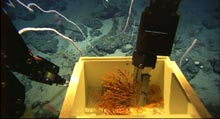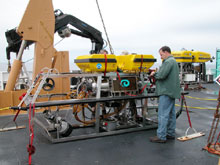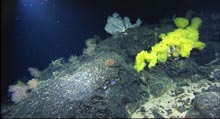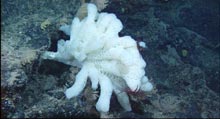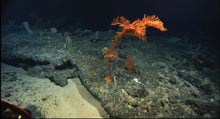IFE ROV Hercules collects corals in a "forest" of bamboo whip corals on Balanus Seamount. Click image for larger view.
The Last Frontier on Earth
May 22-23, 2004
Mary Grady
Adjunct Earth Science Instructor Northeastern University
Lance Arnold
Teacher
Tolland High School
Diana Payne
Biologist and Education Coordinator
Connecticut Sea Grant
Probably the greatest enticement for those who today are devoting their lives to the study of the sea is the lure of the unknown, the challenge of the undiscovered, the thrill of discovery on what is truly the last frontier on earth.
—H. B. Stewart, Deep Challenge
Early Saturday morning, with a sea as smooth as glass, the remotely operated vehicle (ROV) Hercules came aboard after another overnight dive. Its bio boxes were full, and it was carrying a net filled with fossil corals from Balanus Seamount. Among the last scenes from Balanus was a "forest" of enormous bamboo whip corals, some standing 3-4 meters in height.
The ROVs were secured on board, and the Ronald H. Brown was immediately underway for our next destination—Retriever Seamount, which has never before been explored. The ROV crew went right to work preparing for their 4,000-m test dive. The syntactic foam flotation blocks were taken off Little Hercules and strapped to the top of Argus. "Little Herc is our backup for the Titanic cruise," said chief engineer Jim Newman. "That foam has never been down to 4,000 meters, so we're going to test it." The engineers also planned to run hydraulic tests on Hercules, in preparation for next week's visit to Titanic.
Multibeam image of Retriever (left) and Pickett (right) seamounts. Dives were conducted on the southern flank of Retriever. Approximate total relief (from the abyssal plain to the summit) of both features is 2,000 m. Click image for larger view.
IFE bosun Mark DeRoche works to secure foam from Little Hercules on top of Argus for a test dive to approximately 4,000 m. Click image for larger view.
On Saturday night, Hercules was lowered to 3,880 m, where the Institute for Exploration (IFE) team ran a series of tests and collected a few small coral samples. Gastropod feeding patterns were scrawled on the pale yellow sediment that covered the basalts, and opalescent blue sea cucumbers lent color to the otherwise monochromatic scene. Murky sediment covered much of the sea floor, and a few rattail fish lingered around the lights.
During this dive, the educators were invited to sit in the Science One chair and get a feeling for what it's like to be part of the team during a dive. Mary Grady took the first turn, sitting close by Dr. Lauren Mullineaux and clicking a mouse to take "frame grabs" whenever the screen filled with an interesting scene. Next was Lance Arnold's turn. Each got a brief introduction to the myriad screens and buttons that provide information and context to help the scientists interpret what they are seeing.
After spending an hour or so exploring the deep sea floor, Hercules and Argus were winched back up to 2,100 m and dragged behind the ship to a new site about three miles away. Traveling at one knot or less, the trip took several hours. Even transit time, in the blue water column, provides opportunities for scientific observations. The team keeps an eye out for small crustaceans and occasional comb jellies and medusae. A scientist captures in "frame grabs" items of interest for later review and keeps a log to provide detail.
At 2,100 m, some ridges have a considerable abundance of corals and sponges. We saw sea spiders and crabs, and the science team set a new record for this trip, collecting 25 specimens.
The majority of corals collected were of two types: bamboo corals and black corals. The bamboo corals have dark nodes and pale internodes, resembling the appearance of bamboo, with a layer of polyps and soft tissue arrayed on a hard white skeleton. Some grow in long spiraling whips with a single stem; others form branches. We saw a few bamboo whips on this trip that were six to eight feet tall.
The black corals come in a variety of colors, but all have a dense black skeleton beneath the thin layer of polyps. In many areas, black corals are harvested and made into jewelry, killing colonies that could be hundreds of years old.
The exploration continued overnight and through the morning hours. By 8:30 am, the science team was counting down the minutes to the deadline, when the ROVs would have to leave the bottom for the last time. By midday Sunday, Hercules and Argus were winched on board and the ship set a course for Boston Harbor.
The scientists are heading home with dozens of specimens, thousands of digital images, and hours of videotape. "We got terabytes of data," chief scientist Dr. Les Watling said at the wrap-up science meeting Sunday night. "We exceeded all our expectations. I admit I was skeptical of what these ROVs could really do, but they were just fantastic. The IFE crew was so responsive and ready to solve every problem. We've seen what's possible with this technology now, and it's very impressive."
At the meeting, Dr. Watling thanked the crews of both IFE and the Ronald H. Brown for all their help, professionalism, and willingness to constantly work in every way to achieve the objectives of the mission. It was a spectacular cruise, with cooperative weather and capable ROVs. The team accumulated an enormous amount of data and specimens, which will provide a great deal of insight into the ecology and biodiversity of these unique mountains in the sea.
Sign up for the Ocean Explorer E-mail Update List.






















